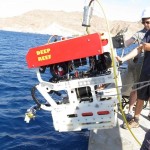 I’ve written a few times recently about using automated devices to explore and protect our oceans. For instance, an Australian project is using drones to protect the coral reef, whilst an Estonian team are using an underwater device to trawl through shipwrecks.
I’ve written a few times recently about using automated devices to explore and protect our oceans. For instance, an Australian project is using drones to protect the coral reef, whilst an Estonian team are using an underwater device to trawl through shipwrecks.
These projects are undoubtedly great, but the machines are seldom deployed in anything requiring fine motor skills, which when dealing with very delicate objects such as coral reef is something of a limiting factor in what machines can do.
A Harvard led project is attempting to fill that gap by developing soft robotics that are capable of non-destructively sampling the fauna on the seabed.
Handle with care
The technology has been documented in a recently published paper with the development of two grippers explained by the team.
The project was inspired by the challenges the researchers had in exploring the deep ocean with existing robotic helpers, which have proven uniformly bad at handling delicate coral, sponge and so on.
So they set about developing something that more closely resembles our own hand, with soft robotics ideal for the task.
They used two distinct approaches to build two distinct type of hand. The first was inspired by the coiling action of a boa constrictor and was designed to access tight spaces and manage small objects. The second was designed with an opposing pair of bending actuators.
Simple construction
The team wanted to enable the devices to be modified and repaired quickly whilst in the field, so went for a simple construction made from inexpensive materials and used a modular design.
This allowed them to use a range of different configurations and to build in bulk to thoroughly test them out.
This modular approach was also in large part a consequence of the complicated environment within which the device would operate. There’s no real way of knowing the size, shape or stiffness of the objects they would need to maneuver on the ocean floor, so they needed to construct something suitably adaptable to cope.
To do this they used the vegetables found in your local supermarket. The produce was placed inside a test tank and then dropped some 800 meters off the Rhode Island coast. The device was then further tested in the northern Red Sea.
Future plans
The team hope to further develop the device so that it’s capable of an expanded repertoire of behaviors. For instance, they’d like it to be capable of testing the samples it collects, and eventually to conduct gene expression and transcriptomatic analysis.
The ability to do this kind of testing on the seabed rather than having to bring the samples to the surface would be a significant advantage as the samples wouldn’t then be exposed to changes in temperature, light and pressure.
They’re also hoping to continue improving the robotics aspect of the project, with tactile feedback added to the learning process in addition to the current visual method of feedback used.
Last, but certainly not least, the team want to enable the device to operate at greater depths. Whilst it has successfully operated at under 200 meters, they would like to eventually be able to explore worlds 6,000 meters below the surface.
There is a fascinating range of projects being undertaken in this field, and this is certainly one more worth keeping an eye on.
If you liked this post, buy me a coffee